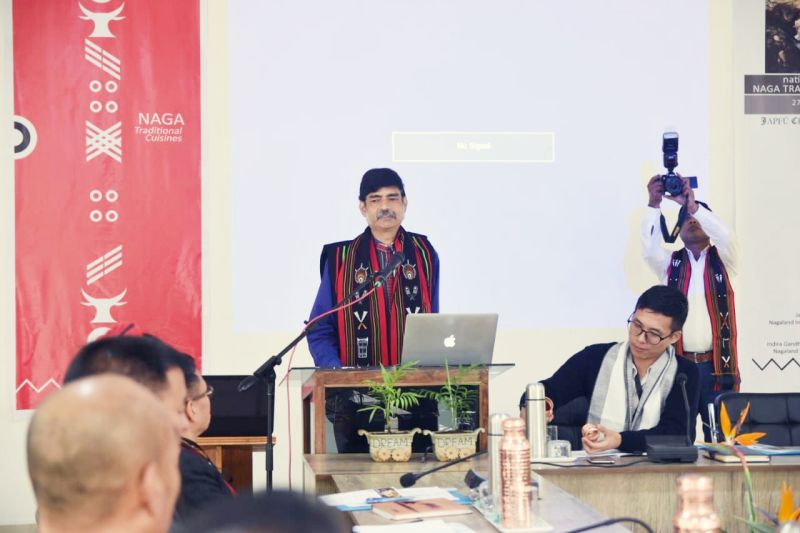Naga Traditional Cuisines: Potential area of research attention

Prof Sarit K Chaudhari addressing the National Seminar on Naga Traditional Cuisines at Japfü Christian College, Kohima on September 27. (DIPR Photo)
Morung Express News
Kohima | September 27
Prof Sarit K Chaudhari opined that food, among many aspects of culture taken for granted has gained prominence in academic discourses since the advent of the ‘cultural turn’ in the sixties of the last century. In the context of Naga society, he said that it is “a potential area of research attention.”
The Director at the Indira Gandhi Manav Sangrahalaya (National Museum of Mankind), Bhopal underscored was delivering the introduction to the National Seminar on Naga Traditional Cuisines at Japfu Christian College, Kohima on September 27.
Understanding Food Cultures
“While consumed on a daily basis and important for our survival, it is often considered as mere sustenance. Food pervades all aspects of our lives from the most intimate to the most professional practices. It is also a key factor in how we view ourselves and others; it is at the center of social and political issues, and today is one of the mainstays of popular media, the Professor underscored.
In the larger context, these academic interests, he viewed has multiple points of entry. As such, he suggested that culinary history focuses on origin and recreation of specific recipes; Archaeologists tries to explore Anthropology; Anthropology or Sociology of food enables us to understand the connection between food and social identity and history offer us the opportunity to explore food historically and culturally. These, the Director added are “powerful markers of social identity.”
In this regard, the Professor pointed that folklore with a narrative factor “enables us to look more closely at how traditional foods are prepared and to draw the boundary between authentic culinary heritage and invented traditions,” and added that it is a potential area of research attention in the context of the Nagas.
Therefore, the exploration of the connection between food and folklore in the society can help in understanding and meaningfully interpreting the notion of social change or emerging social realities and cultural continuity.
Reversal role of food hierarchies
Dr. Sucheta Sen Chaudhari, Central University, Jharkhand who was presenting on “Heritage of Food and Indigenous Communities: Experiences from Northeast India” proposed how food hierarchies has taken a reversal role. For instance, for many centuries, a few cereals were considered the food of the aristocrats while some as the common man’s food. But with changing factors and aspects of climate change and global warming, cereals especially the millet has come to be considered as the dominant and future food.
She suggested to work with people, re-cultivate knowledge with people and communities who maintain these knowledge; communities who are self-independent food and fodder producers.
Dr Visakhonu Hibo, Principal Japfu Christian College during the welcome address stated that the time has come for us to seriously explore the traditional Naga cuisine and take forward even with the Act East Policy knocking at our door and prepare to meet the changing scenario.
Around 10 papers on diverse topics on Naga traditional foodlore and cuisines were discoursed. Dr A Husca in his paper ‘Axone’ observed that “food is a culture in itself;” which overtime and with changing trends has become a form of economy. “The Chakhesang Wrestlers’ diet” presented by Muleho Khesoh portrayed how food formed the central component of preparing the wrestler for gaining weight, strength and stamina. Neingusanuo Solo gave an insight on how food played the role of “social capital currency” in reference to Yangpi Village of Tuensang district.
Thokhwemi Vahi, a paper on the food of the cow herdsmen engaged in the practices passed and preserved through the herdsmen in the Angami Naga society in the past. Origins, processes of preparation, significance of cuisines of the Angamis, Aos or particularly the Muodi (Angami) and Awo Kutsu (Sumi) and local sausage of Sawombung were among other papers presented.
Dr. Sucheta Sen Chaudhuri later expressed the need for introducing the subject in school curriculums.






